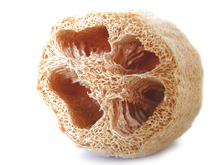en
names in breadcrumbs


The Sponge Gourd or Loofah (Luffa aegyptiaca) is widely valued for its interior fibers. Dried, these gourds are used for scrubbing and cleaning (among other uses). This plant is native to Asia (possibly India) and was first grown commercially in Japan in 1890. It was subsequently brought to the American tropics. Sponge Gourds are commonly used to exfoliate and cleanse the skin during bathing. (Prance 2004) This species has often been called L. cylindrica.
After mature Sponge Gourds are harvested, they are soaked in water to encourage decay of the outer fruit wall and inner pulp, then washed thoroughly to remove extraneous material. The remaining fiber is dried in the sun and bleached white. Sponge Gourds are grown widely in Asia, especially China, and in the New World, especially Guatemala and Colombia. (Sargent and Maynard 2012 and references therein) They are cultivated and naturalized across Africa, where they grow as weeds around cultivated crops and in disturbed habitats (Neuwinger 1996).
Luffa aegyptiaca, the sponge gourd,[2] Egyptian cucumber or Vietnamese luffa, is an annual species of vine cultivated for its fruit, native to South and Southeast Asia.
The three-lobed leaves are 7.5–20 centimetres (3–8 inches) wide.[3]
The fruit, approximately 30 cm (12 in) long and maturing to brown, resembles a cucumber[3] in shape and size.
The synonymous botanical specific epithet "aegyptiaca" was given to this plant in the 16th century when European botanists were introduced to the plant from its cultivation in Egypt. In the European botanical literature, the plant was first described by Johann Veslingius in 1638, who named it "Egyptian cucumber". Veslingius also introduced the name "Luffa".[4]
According to researchers in Florida, common cultivars for Luffa aegyptiaca include Smooth Boy, Smooth Beauty, and South Winner.[5] Many other cultivars were also mentioned in the Vegetable Cultivar Description for North America List 24, 1999:[6]
The young fruit is eaten as a vegetable and is commonly grown for that purpose in tropical Asia. The young shoots, flowers and leaves can be cooked, and the mature seeds can be roasted for consumption.[3]
Unlike the young fruit, the fully ripened fruit is strongly fibrous and inedible, and is used to make scrubbing bath sponges. Due to the use as a scrubbing sponge, it is also known by the common names dishrag gourd, rag gourd, sponge gourd, and vegetable-sponge.[1] It is also called smooth luffa to distinguish it from the ridged luffa (Luffa acutangula), which is used for the same purposes.[1]
An edible oil can be extracted from the seeds. The resulting oil meal can be fed to rabbits and catfish, or used as a fertilizer.[7]


In Israel, Luffa aegyptiaca has been in use since the time of the Late Roman Empire. Young fruits were used for food. Mature fruits were used as bath sponges. Luffa aegyptiaca fruits were decorated for the first time in art of the Byzantine era in Israel only. The fruits were decorated on mosaics of churches and synagogues in Israel.
Luffa has been cultivated throughout Asia for centuries for use as a household cleaning agent and is now, due to the gently abrasive quality of the natural fibers, a popular exfoliating agent in the eco-friendly cosmetic industry.[8] Owing to its striking yellow flowers, the plant is occasionally grown as an ornamental.
It requires much heat and much water to thrive.[9] However, Luffa aegyptiaca can be cultivated in temperate climates. Research from North Carolina suggests that commercial production of luffa in the United States could be economically viable.[10]
Techniques that contribute to success in growing luffa include using black mulch to warm soil temperatures and transplants to increase the germination rate and extend the growing season. Narrow spacing may result in poorer quality sponges.[8] It is best grown with a trellis support for its curled tendrils to hang on to.[11][12]
{{cite book}}: CS1 maint: others (link) {{cite web}}: CS1 maint: unfit URL (link)  Leaves, flower and fruit of a luffa
Leaves, flower and fruit of a luffa Luffa aegyptiaca, the sponge gourd, Egyptian cucumber or Vietnamese luffa, is an annual species of vine cultivated for its fruit, native to South and Southeast Asia.